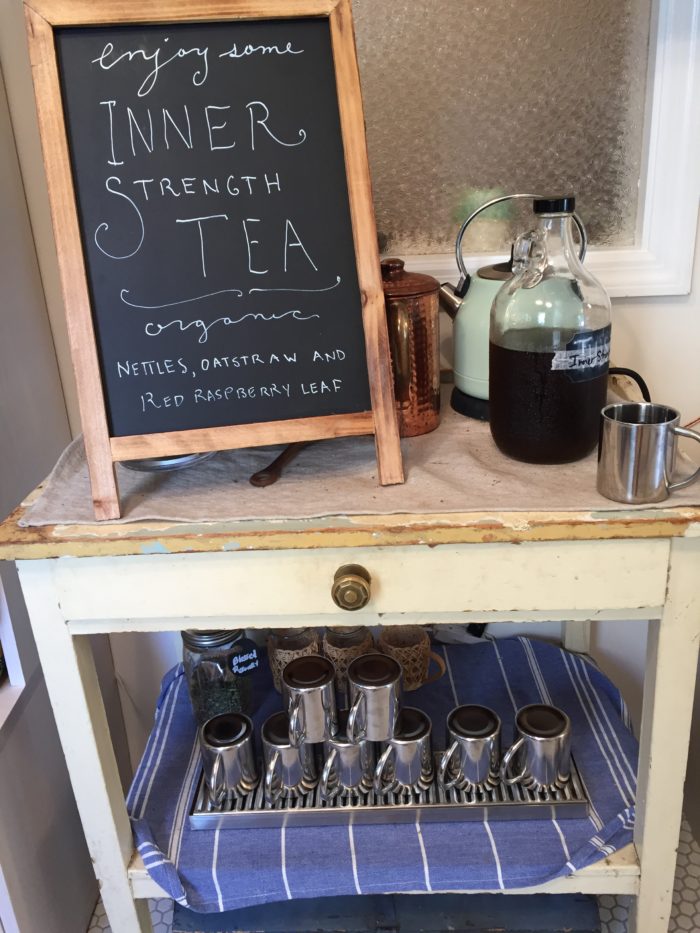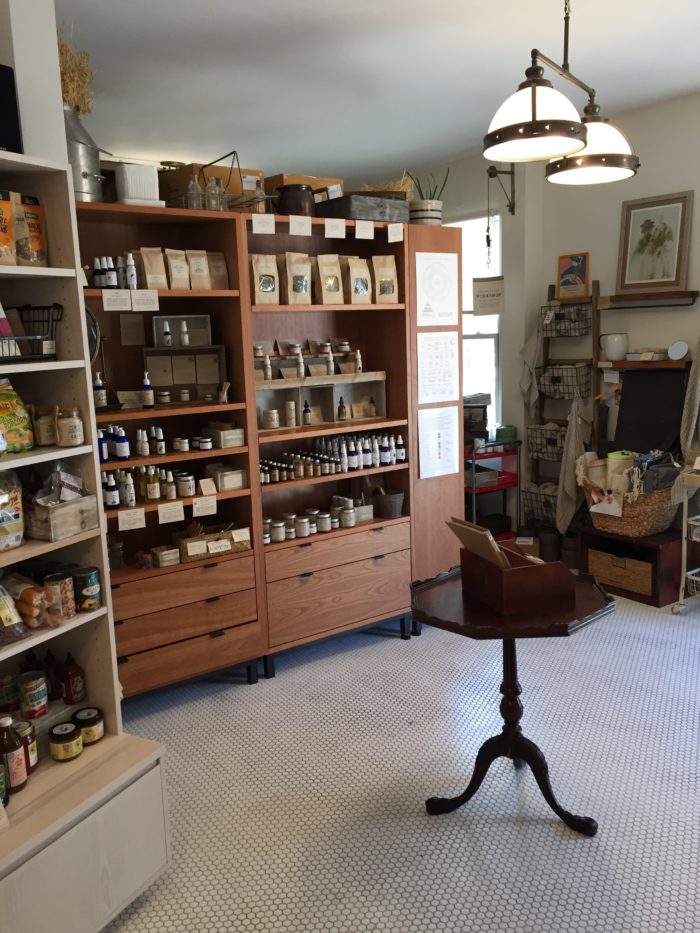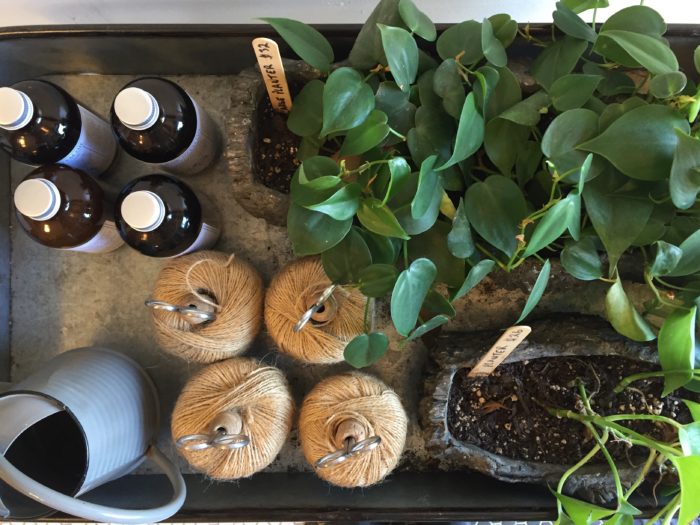I’d never seen so many monarchs in nature. As I was led to the secluded, aptly named “Butterfly Garden” nestled behind Molly Watman and Emma Graves’s charming studio/store Brooklyn Herborium, unassumingly situated on a corner of Prospect Avenue in Brooklyn, I felt transported in a way that a place hadn’t affected me in quite a while. It helped that Emma, my host for the afternoon, and I were both sipping small tin cups of their signature Inner Strength iced tea (a pitcher sits on a table when you walk in the store, greeting shoppers like family); that the din of the highway traffic was somehow blocked; that the soothing aromas of the Between You & the Moon product line, sold and made right there at the store, was wafting from just behind the screen door. I didn’t feel like I was in Brooklyn (even the un-city hipster part), but rather in a calm, urban oasis of healing.
The effect is not just magic, but undoubtedly an intentional component of the women’s philosophy in both business and herbalism. Nor is it artificial in any way; harmony between inner- and outer-self seems to exude from Emma’s (completely invisible) pores. The woman sitting before me was utterly composed in the unusual October heat. With her hair pulled back, her milky, porcelain complexion was living proof of her method’s efficacy.
Beauty, though, is not quite what Emma is after when she treats clients through a variety of holistic spa treatments, also done here on-site by Emma herself, and formulates her line of mists, oils, teas, and other face and body products. Rather, as an esthetician she’s offering a “touch, hands-on service,” she says, an experience that goes deeper to massage people’s brain, and share the benefits of functional herbalism, modernizing the traditions of ancient Chinese, Indian, and other cultures to meet the needs of today’s women (and men).
Her commitment to giving people a way to heal from the outside in has driven her story from the get-go. Today, many people think that with the mind-body-spirit paradigm, fixing the inside is the first step. Get your intentions and feelings sorted, and you’ll be beautiful. Not so much, says Emma. Rather, “Most people can come to realization of life through what’s happening on the top. I don’t think it’s superficial to see things superficially. That is a manifestation of everything.” By balancing and not controlling your body, especially the skin, you’ll “naturally find yourself in spiritual equanimity. You’re not going to be able to find that until you’ve incorporated it in corporal ways.”
Brooklyn Herborium products surprised me (a self-proclaimed serum addict) because of how they work counter to popular advice on skincare routines. But the logic behind it is so sound, I immediately felt bad for not only following but giving wrong advice! Between You & the Moon is designed to not suppress or control the skin, as many an anti-aging/wrinkle/blemish/dark circle/etc. products do, but rather to use herbs as nourishment toward that desired “spiritual equanimity,” aka “radiance.” The method is built in a pyramid with three parts that together let the body work as it should to defend itself from external and internal stressors.
First is lubrication and hydration, i.e. oil and water. Here was shocker #1 one in our conversation, for Emma explained that balancing the two comes from doing the opposite of what we’re usually told. When the air is dry (i.e., lacking water), as it tends to be in fall and winter, you don’t give the skin more oil, but more water; vice versa in humid weather, when you’d decrease the water. (People who say they feel “oily” in the summer, she says, are often just sweaty–i.e., wet.) Customizing the oil:water ratio is easy with her pairings of oil and hydrating mist. The basic formula is 3 drops of oil and 5 sprays of water, which emulsify when you combine them in your hand. This technique is also extremely efficient, since you’re so specific about how much you use each day the products last a long time. When it’s humid, the ratio becomes 4:6; when it’s dry, 3:6. (I tried this out myself the past few days, when NYC has gone in and out of humidity fluxes, and it’s worked like a charm! My face was perfectly balanced, neither greasy nor dry, such that I paid no attention to it at all.) Separating the two elements prevents the need for preservatives, and the sprays come in a variety of formulas based on your needs (“the nose knows,” she says—and again she was right as one I chose is made for those “looking to find your place in the world”…).
Next is cellular communication, achieved through elimination. Emma explains that our skin is barraged with “confusing stuff” that comes from the environment, including suppressing products. All that needs to come out through clay masks and steaming, which detoxifies pores.
Finally, there’s structural integrity: allowing the skin to do its job as the first line of defense against the world. Cleansing ensures that the skin does not break down but rather become strengthened through the transdermal absorption of carefully chosen herbal combinations. Her method prescribes an oil cleanser nightly, plus 3-6 times a week mixing oil with a grain-based scrub.
We’re in a unique moment when Western medicine, which subscribes to a “plug-and-play” or ”add-or-avoid” paradigm, using herbs as drugs, is coming into question. But we’re resistant to letting go of this “heroic” mentality and embracing instead the feminine, nourishing side of ancient medicine. Emma is offering a way to incorporate “functional herbalism”–so named because they’re making things function—and teach the body what give itself what it needs naturally. We can make vitamins and minerals more bioavailable when we achieve corporeal balance; we’ll also be less aggravated when pollutants or even things like gluten and sugar enter our bodies, a fact that’s simply unavoidable in today’s world.
It’s important to consider the notion of growth when adopting an ancient medicinal model, too. She explains, “The time and place of what was taught in ancient Ayurveda or Chinese medicine was really focused on meeting the needs of the people who lived in that time and what was surrounding them. Our needs are different now. It’s okay to look at those techniques and say, ‘Aha, I can get something from that technique’—and grasp the essence of it…but it’s not what’s necessary for the client in front of me right now living in New York City. Just because something was traditionally done, doesn’t mean we have to do it that way.”
Also by Jennifer: Coconut Oil Has Lost Its Superfood Status–But Why You Should Keep It Around
Get more like this—Subscribe to our daily inspirational newsletter for exclusive content!
__
Photo: Sarah Gray on Unsplash; Jennifer Kurdyla




